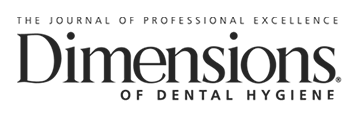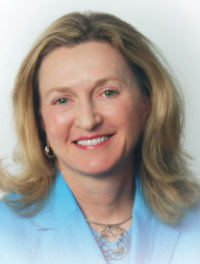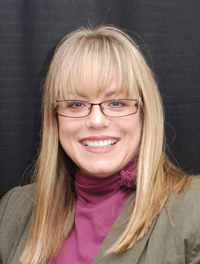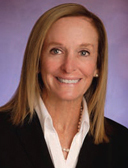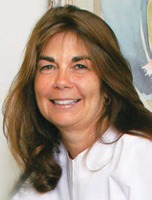
After working in private practice in Northern California for more than 25 years, Karine Strickland, RDHAP, BS, decided to go back to school to earn an alternative-practice credential. In 2005, after completing the program at the University of the Pacific Arthur A. Dugoni School of Dentistry in San Francisco, she became a registered dental hygienist in alternative practice (RDHAP). Today, Strickland owns Hygentlecare, a successful RDHAP business that serves older adults who are homebound or living in skilled nursing or long-term care facilities, as well as patients with developmental disabilities. Dedicated to lifelong learning, she recently earned a certification in orofacial myology, enabling her to provide this therapy to patients, as well.
Strickland also is an active participant in organized dental hygiene and has served extensively at the local and state levels. She was president of the Monterey Dental Hygienists’ Association from 2007 to 2010 and is president of the California Dental Hygienists’ Association (CDHA).
What motivated you to start your own practice?
I took the initial step toward independent practice while working for a dentist. He co-founded a dental materials company, which required him to spend much of his time away from the practice. For about 6 months, I provided patients with dental hygiene services and the office manager scheduled patients for hygiene recare and restorative treatment based on my observations and evaluations while working under general supervision. This opportunity served as a natural transition to starting my own practice. At the same time, I met two young dental hygienists who had just graduated from the first class of the University of the Pacific’s RDHAP program and were involved in the care of individuals with developmental disabilities. They were part of an extended program within the university that developed dental coordinators within the California Regional Center system. Clinicians at these centers, which are funded by California’s Department of Developmental Services, provide medical and dental services to patients with developmental disabilities. One of the dental hygienists was relinquishing her position and encouraged me to apply for the job.
I initiated my dental hygiene practice in 2005 and was selected to contract with the San Andreas Regional Center as a dental coordinator in 2006. The adult benefits of Denti-Cal—which is part of California’s Medi-Cal program and provides access to oral health care services for indigent residents—were fully reinstated in 2009 for regional center consumers with developmental disabilities. At this time—partially due to my urging—the San Andreas Regional Center approved the use of an RDHAP program to provide clinical preventive and periodontal services for developmentally disabled populations. I am extremely proud of this program. I was also able to work with my regional center to provide clinical care for this patient population. I was integral in coordinating a group of RDHAPs who provide in-home preventive and periodontal procedures for medically fragile individuals and patients who need general anesthesia or conscious sedation in order to receive treatment. We have been amazingly successful with these individuals—building a bond that is difficult to express in words, but allows for thorough and ongoing care.
You are president of CDHA. Why do you believe it’s important to be involved in organized dental hygiene?
I joined the professional association upon licensure and have maintained my membership throughout my career. It was not until I started attending component and state meetings that I understood how much support is provided by the American Dental Hygienists’ Association and its state and local components. I would not own an independent dental hygiene practice without the diligent legislative persistence of CDHA. The scope of practice for dental hygienists in California is vigilantly maintained and protected by ongoing CDHA efforts. We must work together through our association to seek legislative changes that will allow dental hygienists to successfully become advanced dental hygiene practitioners. CDHA strives to support its members with educational opportunities, including informative seminars regarding alternative career paths. The association and its components also support and coordinate dental hygiene volunteers for many local community outreach events, as well as raise funds for a variety of nonprofit associations. My involvement with CDHA has provided countless opportunities to grow personally and professionally, as well as to make lifelong friendships.
What are the advantages of owning a dental hygiene practice? What are the greatest challenges?
The greatest benefits I receive from treating underserved populations are often not verbalized, but rather provided by the look in my patients’ eyes as they allow me to administer thorough periodontal care. I value the opportunity to deliver oral health services for patients who are so appreciative—many of whom have not received professional dental care for many years. Additionally, scheduling flexibility, which accommodates my commitment to serve and promote California dental hygienists as president of the CDHA, is another great advantage to owning a dental hygiene practice.
One of the challenges many RDHAPs face is establishing their patient base. My practice has grown steadily each year with referrals from patients, family members, visiting nurses, dentists, and physicians. Because I treat mostly older adults, however, the care I provide is often short-term. Also, California requires a medical order from a physician or a prescription from a dentist in order for patients to receive care from RDHAPs. Many physicians decline to comply, while others are appreciative of the consult and will often prescribe antibiotics prior to prophylactic care. Additional challenges include: high overhead costs for services vs low Denti-Cal (part of California’s Medicaid program) reimbursement; private insurance not recognizing the RDHAP licensure, thus requiring payments to be made only to licensed dentists; high employee overhead; lack of collaborating dentists to address patients’ restorative needs; sustainability of dental care services; and inability to provide interim restorative care and simple extractions due to scope of practice limitations.
You are also certified in orofacial myology. How do you see this fitting into the dental hygiene process of care?
Dental hygienists are in a unique position to develop trusting relationships with patients. As health care providers, we should be initiating conversations about many aspects of a patient’s overall health and well-being. Recognition of sleep apnea symptoms and referral for care can save lives. Just as dental hygienists are responsible for providing oral cancer head and neck exams, conducting assessments for signs of sleep apnea should also be part of our standard of care. Incorrect swallowing and tongue thrusting can cause facial growth distortion, temporomandibular disorders, and malocclusion. Dental hygienists with a deep understanding of head and neck anatomy and facial musculature who complete the required coursework can become certified orofacial myofunctional therapists. Some dental practices allow dental hygienists to provide orofacial myofunctional therapy as an adjunct service. This practice may become increasingly accepted as more dentists begin to diagnose and treat patients with sleep disorders. This is a unique opportunity for collaboration, and dental hygienists with expertise in orofacial myofunctional therapy can be invaluable additions to dental practices.
